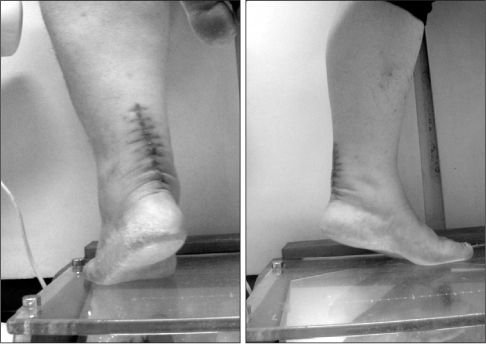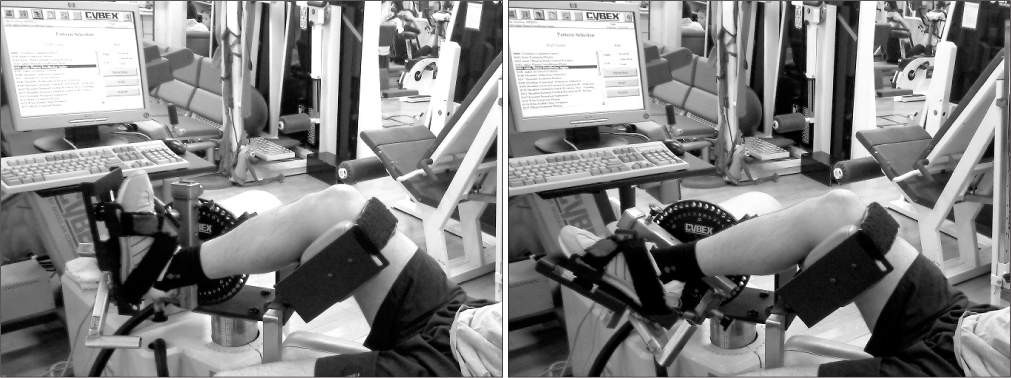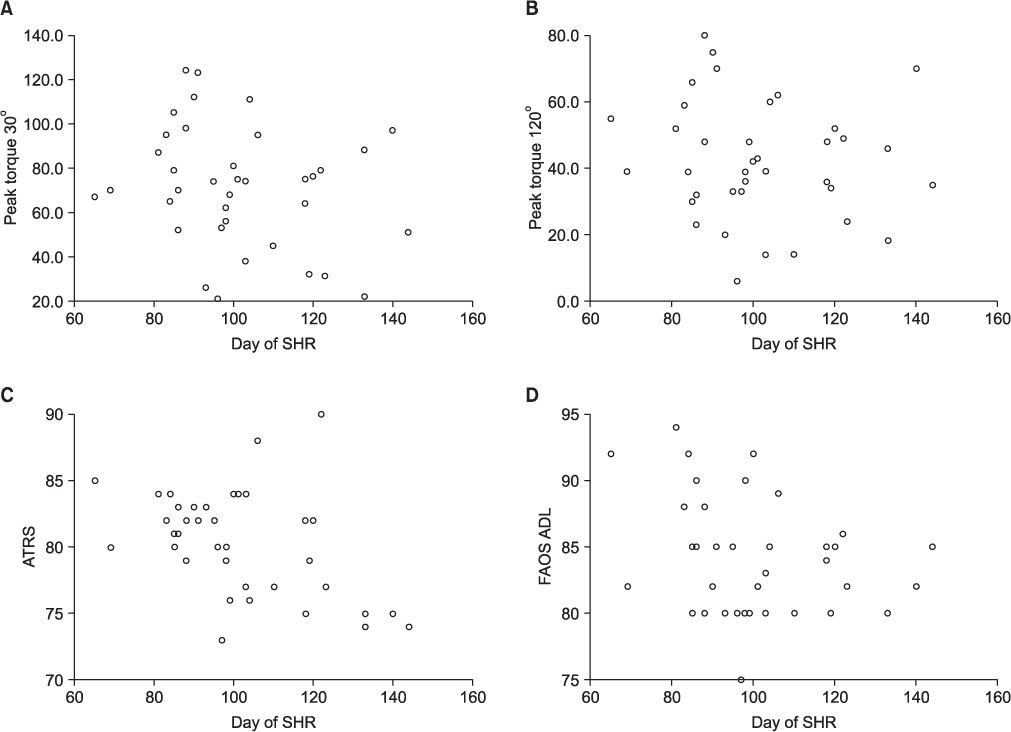J Korean Orthop Assoc.
2013 Apr;48(2):96-103. 10.4055/jkoa.2013.48.2.96.
Analyses of Timing of Single Heel Raise and Muscle Power after Achilles Tendon Repair
- Affiliations
-
- 1Department of Orthopedic Surgery, Ilsan Paik Hospital, College of Medicine, Inje University, Goyang, Korea. sjs0506@paik.ac.kr
- KMID: 1424093
- DOI: http://doi.org/10.4055/jkoa.2013.48.2.96
Abstract
- PURPOSE
The purpose of this study is to analyze the progress of muscle rehabilitation for patients with acute Achilles tendon rupture, who underwent Achilles tendon repair, checking capable time of single heel raise and isokinetic plantar flexion power.
MATERIALS AND METHODS
From March 2006 to June 2011, 42 of 81 patients were excluded and the other 39 patients, who underwent surgery due to acute Achilles tendon rupture in our institute, were enrolled in this study. The operation and rehabilitation were constantly performed according to the author's method. Isokinetic plantar flexion power was measured at three months post-operation, capable time of single heel raise was assessed, and clinical results of the last follow up were measured and analyzed.
RESULTS
Single heel raise was possible at an average of 14 weeks and three days, and repetitive single heel raise more than 10 times was possible at an average of 20 weeks. The peak torque of 30degrees/s plantar flexion was mean 69 Nm. The peak torque of 120degrees/s was 41 Nm. Assessment at three months post-operation showed 69% power, compared to the contralateral leg. The group of patients who were able to perform single heel raise within three months, showed better Achilles tendon total rupture score and foot and ankle outcome score at last follow up, and showed better plantar flexion power at three months post-operation.
CONCLUSION
At the last follow up, we can expect better clinical results and muscle power in patients who are able to perform single heel raise early treatment of acute Achilles tendon rupture.
Figure
Cited by 1 articles
-
Measurement of Muscle Strength of Ankle Joint Using Isokinetic Dynamometer in Normal Korean Adults
Seung-Myung Choi, Ji-Kang Park, Yoon-Won Ha, Byung-Ki Cho
J Korean Foot Ankle Soc. 2015;19(4):142-150. doi: 10.14193/jkfas.2015.19.4.142.
Reference
-
1. Leppilahti J, Puranen J, Orava S. Incidence of Achilles tendon rupture. Acta Orthop Scand. 1996. 67:277–279.
Article2. Maffulli N, Waterston SW, Squair J, Reaper J, Douglas AS. Changing incidence of Achilles tendon rupture in Scotland: a 15-year study. Clin J Sport Med. 1999. 9:157–160.3. Silbernagel KG, Nilsson-Helander K, Thomeé R, Eriksson BI, Karlsson J. A new measurement of heel-rise endurance with the ability to detect functional deficits in patients with Achilles tendon rupture. Knee Surg Sports Traumatol Arthrosc. 2010. 18:258–264.
Article4. Jun AY, Hwang BG, Cha SH, et al. Recovery of muscle power following early weight-bearing and ankle exercise after surgical repair of acute Achilles tendon rupture. J Korean Orthop Assoc. 2012. 47:111–118.
Article5. Arner O, Lindholm A. Subcutaneous rupture of the Achilles tendon; a study of 92 cases. Acta Chir Scand Suppl. 1959. 116:1–51.6. Nilsson-Helander K, Thomeé R, Silbernagel KG, et al. The Achilles tendon Total Rupture Score (ATRS): development and validation. Am J Sports Med. 2007. 35:421–426.7. Roos EM, Brandsson S, Karlsson J. Validation of the foot and ankle outcome score for ankle ligament reconstruction. Foot Ankle Int. 2001. 22:788–794.
Article8. Jacobs D, Martens M, Van Audekercke R, Mulier JC, Mulier F. Comparison of conservative and operative treatment of Achilles tendon rupture. Am J Sports Med. 1978. 6:107–111.
Article9. Lo IK, Kirkley A, Nonweiler B, Kumbhare DA. Operative versus nonoperative treatment of acute Achilles tendon ruptures: a quantitative review. Clin J Sport Med. 1997. 7:207–211.10. Leppilahti J, Orava S. Total Achilles tendon rupture. A review. Sports Med. 1998. 25:79–100.11. Möller M, Movin T, Granhed H, Lind K, Faxén E, Karlsson J. Acute rupture of tendon Achillis. A prospective randomised study of comparison between surgical and non-surgical treatment. J Bone Joint Surg Br. 2001. 83:843–848.12. Henríquez H, Muñoz R, Carcuro G, Bastías C. Is percutaneous repair better than open repair in acute Achilles tendon rupture? Clin Orthop Relat Res. 2012. 470:998–1003.
Article13. Fortis AP, Dimas A, Lamprakis AA. Repair of achilles tendon rupture under endoscopic control. Arthroscopy. 2008. 24:683–688.
Article14. Aktas S, Kocaoglu B. Open versus minimal invasive repair with Achillon device. Foot Ankle Int. 2009. 30:391–397.
Article15. Krackow KA, Thomas SC, Jones LC. A new stitch for ligament-tendon fixation. Brief note. J Bone Joint Surg Am. 1986. 68:764–766.
Article16. Carter TR, Fowler PJ, Blokker C. Functional postoperative treatment of Achilles tendon repair. Am J Sports Med. 1992. 20:459–462.
Article17. Maffulli N, Tallon C, Wong J, Lim KP, Bleakney R. Early weightbearing and ankle mobilization after open repair of acute midsubstance tears of the achilles tendon. Am J Sports Med. 2003. 31:692–700.
Article18. Suchak AA, Bostick GP, Beaupré LA, Durand DC, Jomha NM. The influence of early weight-bearing compared with non-weight-bearing after surgical repair of the Achilles tendon. J Bone Joint Surg Am. 2008. 90:1876–1883.
Article19. Silbernagel KG, Steele R, Manal K. Deficits in heel-rise height and achilles tendon elongation occur in patients recovering from an Achilles tendon rupture. Am J Sports Med. 2012. 40:1564–1571.
Article20. Olsson N, Karlsson J, Eriksson BI, Brorsson A, Lundberg M, Silbernagel KG. Ability to perform a single heel-rise is significantly related to patient-reported outcome after Achilles tendon rupture. Scand J Med Sci Sports. 2012. Published online Jun 21, 2012. doi: 10.1111/j.1600-0838.2012.01497.x.
Article
- Full Text Links
- Actions
-
Cited
- CITED
-
- Close
- Share
- Similar articles
-
- Correlation between a Rupture of the Hypovascular Zone and Early Single Heel Raising after Achilles Tendon Repair
- Surgical Treatment of Achilles Tendon Rupture with Absorbable Suture Materials Only
- Reconstruction of Neglected Achilles Tendon Rupture with Flexor Hallucis Longus Augmentation Using One Incision Technique
- Reapir of the Torn Achilles Tendon, Using the Plantaris Tendon
- Surgical Outcome of Reconstruction of Neglected Chronic Achilles Tendon Ruptures




